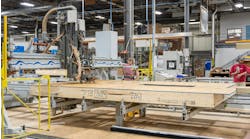The mild climate and new job opportunities are attracting Americans to Southern cities like a magnet, driving increased activity in the electrical construction market.
“During the recession, it kept Americans in place because they couldn’t sell their houses at an acceptable price, and they couldn’t find any better job prospects elsewhere,” says Ken Simonson, chief economist for Associated General Contractors. “Over the last couple of years, the migration has picked up speed, and the southeastern states have benefitted. Because the Southeast is attracting more population growth, the demand for home building will be higher.”
For example, corporations are rapidly migrating to Texas, which is igniting a commercial construction boom, says Erik Kluetz, manager of business and operational development for Walker Engineering in Irving, Texas.
“We are seeing a continuous amount of new projects in the four major cities that we service here in Texas,” Kluetz says. “In the greater Houston area, hospitals are spending more than $2 billion on expansions and new buildings to keep up with the growing population. Also, Austin, Dallas, and San Antonio have seen a number of corporate office campus developments and higher education, health care, and mission-critical projects get off the ground in 2016.”
According to a 2015 study by consultant Joseph Vranich, 1,510 companies moved part or all of their operations out of California from 2008 to 2014, and 219 — or 15% — relocated to Texas. As a result, Texas gained 37,553 jobs and $6.47 billion in investment, according to a story in the Dallas Morning News. An increasing number of corporations are relocating their headquarters to Texas for several key reasons — lower overall taxes, no state income tax, and other incentives, such as tax-increment financing, Kluetz says.
In addition, Vincent Real, president of Big State Electric, Ltd., in San Antonio, says manufacturers and businesses are selecting the Southern region because wages and salaries are lower than on the East and West Coasts, and there are less regulatory laws and regulations. He says Texas leadership is doing a good job of keeping the construction industry stable.
“We have been very fortunate due to national and worldwide interest in Texas,” Real says. “We are seeing a lot of property being bought up by outside interest due to lower property and electric utility cost. Because of this, we are seeing property go up in both city and rural areas, and the market is vibrant and full of opportunity.”
Embracing opportunities
Strong construction activity is underway not only in Texas, but also in other Southern states. For example, the market is thriving right now in the Atlanta area, says Kristen Williams, president of Penco Electrical Contractors, Inc., in Morrow, Ga.
“Just drive through downtown Atlanta, and you will see an abundance of tower cranes,” Williams says. “Multifamily and hospitality markets are really booming here.”
In nearby Tennessee, Brian Haines of Memphis-based Pyramid Electric says the electrical market is revitalizing, and its future is promising.
“While my other colleagues across the country are busy and hard at work in their marketplaces, it’s a good time to be a contractor in the South,” Haines says. “The electrical construction market in western Tennessee is vibrantly active.”
Much of the construction demand that was suppressed during the sluggish economic times is now coming back to life. As a result, Haines says not only does his company have a high level of production and backlog, but also all of its quality electrical contractor colleagues have a lot of work underway.
“Significant projects that owners have been holding in the design phase are hitting the market rapidly,” Haines says. “Others appear to be pressing the design cycle and being bid prior to the completion of all details, decisions, and coordination efforts, resulting in constant change on projects.”
Market growth
Nearly all Southern states are currently experiencing heightened construction activity with a few exceptions, Simonson says. For example, Florida is reporting strong activity, especially in the residential sector. While single-family housing lagged in the Southeast, he expects it to improve in 2017.
“Florida was late coming out of the recession and had a huge overhang of housing,” Simonson says. “We are now seeing more luxury condos being built in the Miami area and huge tracts of new housing in southwest Florida and other parts of the state. There’s a lot of construction going on in Florida right now.”
In addition to a surge in single-family home building, Florida is also experiencing an uptick in activity in other sectors, such as hotels, multifamily construction, highways, airport, and high-speed rail from Miami to Fort Lauderdale to Orlando, he says.
Savannah, Ga., is attracting new investment related to the widening of the Panama Canal, and farther up the coast Charleston, S.C. and Nashville, Tenn. are showing strength in the construction market. Within the Southern region, Simonson is seeing a growth in the wind, solar, and power generation markets. In addition to natural gas power plant construction, he is keeping an eye on the pipeline construction from the shale region into the Southeast, but he says the timing remains uncertain.
Big State Electric, with headquarters in San Antonio and additional offices in Austin and Houston, is seeing activity in the light and heavy commercial sector as private, public, and national companies open new operations or expand existing facilities.
“The industry, at the moment, has opportunities available,” Real says. “In all three of our markets, we are seeing public and private schools, higher education, medical, technical, research, and city utility projects.”
In the Austin office, the contractor is experiencing more activity in the high-rise living condominiums/retail, and some high-tech projects. In Houston, the contractor has bid on commercial projects and has some large medical opportunities in the near future, Real says.
Kluetz of Walker Engineering, which also operates offices across Texas, says construction opportunities include ongoing expansion of transportation infrastructure, new forms of transportation, such as light rail and high-speed rail, as well as new forms of energy production, like wind and solar, in west Texas. At this point, the most active markets for the company have been health care, private development/corporate office campuses, and higher education.
“These markets will continue to grow as more and more companies relocate to Texas, creating a greater demand for new roads, schools, retail, and hospitals,” Kluetz says.
Specifically within the education sector, Kluetz says he is noticing a slight uptick in the amount of K-12 education projects, including high school sports facilities and low-voltage work in schools in the outlying suburbs of San Antonio and Austin, which have received capital improvement funding.
Meanwhile, in Georgia, the multifamily, hospitality, K-12, and higher education markets are thriving, along with the interstate projects, multifamily sector, and the hotel industry, Williams says. While the commercial sector still seems to be down, she says several large high-rise complexes may be about to start. Also in her area, she has noticed a trend of building with the concept of “Live, Work, Play” with multiple types of buildings and facilities in one location.
In the Atlanta area, two major stadium projects are under construction, which is spurring other projects to feed, house, and entertain the game attendees, Williams says. As long as the Falcons and Braves stadiums are under construction, labor will be tight, notes John Cleveland, president of Cleveland Electric, which is working on the Atlanta Falcons Stadium.
Bruce Taylor, president of Marathon Electrical Contractors in Birmingham, Ala., says in northern Alabama, several large industrial projects are starting or are midway to completion. In addition, the contractor is working on a significant amount of health care work, which has recently picked up. For example, the company has three medical projects in North Carolina, just finished up a large hospital near Birmingham, and will soon work on a standalone emergency facility.
Beyond the health care sector, the contracting company is also pursuing work in the office, industrial, service, and communications markets. In addition, the company has traditionally been a government contractor, the work has picked up steam recently, and the market is coming back, Taylor says.
In the west Tennessee, Memphis, and Shelby County areas, Pyramid Electric is seeing expansion in the education arena all the way from the elementary level to the university and post-graduate level. For example, the contractor is currently working on a new 540,000-sq-ft high school as well as a new 60,000-sq-ft elementary school addition. These projects are the result of local municipalities developing their own school systems. Furthermore, Haines has witnessed growth in the transportation, health care, commercial, institutional, and tenant infill markets. While the residential development is still lagging in his area, it is moving forward, he says.
Commercially, Pyramid Electric is currently working on several projects within the 1.5-million-sq-ft Crosstown Concourse development. A city block, which contained a former Sears and Roebuck distribution and retail center, will soon include three floors of residential units and several floors of medical and commercial space wired by Pyramid Electric along with a large theater addition to the property.
“New projects for this space are coming out on the market monthly,” Haines says.
Slowing markets
While many of the Southern states are seeing a surge in opportunities in the construction market, not all areas are experiencing a ramp-up in activity. The base realignment and cutback in military spending by the U.S. government has impacted several Southern states, including Georgia, Virginia, and North Carolina, Simonson says.
In addition, while the office construction market has become strong in many downtown areas nationwide, Virginia is still reporting high office vacancy rates, Simonson says. Other Southern states, such as Kentucky, Mississippi, and western Tennessee, are also lagging behind other parts of the economy in certain construction markets.
Another market being hit hard throughout the Southern region is the oil and gas sector. Kluetz says oil and gas companies will continue to hold off on major capital improvement projects while crude oil prices are low. In Georgia, Cleveland Electric has also seen a slowdown in opportunities in coal burning powerhouses, Cleveland says.
Within other Southern states, the amount of construction activity varies from one city to the next. For example, Taylor says the market is growing in the northern part of the state, stagnant in the central section, and growing moderately in southern Alabama.
“The market is on fire in Huntsville, Alabama, and if you throw Atlanta, Charlotte, and Nashville into the mix, the South is booming,” Taylor says. “In Birmingham, however, it is slowing down. Because we don’t have the work in our home base, we have to travel a lot. We work across the Southeast and then have a piece of our company that works all over the world,” Taylor says.
To handle projects out of state, Marathon Electrical Contractors brings its project management, job superintendents, and foremen to the work site and then hires local labor to handle installation. To save time and money, the contractor also prefabricates much of the materials at its facility in Birmingham, Ala., and then delivers them to the work site.
Rising margins
Because the construction market is so active in many Southern cities, electrical contracting companies are seeing higher margins, but also a tight labor market. While construction has always been a competitive market, margins are slowing rising due to the fact that the market is so busy, Williams says.
“Currently, there are more diverse projects than there are subcontractors to install them, and we are trying to hold on to our margins,” she says.
Haines says while competition in his region is still crowded on bid day, margins are broadening slowly.
“We attempt to manage the quantity of our competitors by pursuing the larger, more difficult and challenging work in our market, thus reducing the number of contractors both capable and interested in the projects we bid,” Haines says.
Due to the amount of projects ongoing in Texas, both competing and non-competing contractors are experiencing higher margins in general across all market segments, Kluetz says.
“I’ve talked with other subcontractors, including painters, drywall, and mechanical contractors, and most commercial construction companies right now are able to keep all of their field personnel busy to the point that they are actively recruiting additional staff to meet project demand,” Kluetz says.
While a commercial construction boom is currently underway in Texas, the shortage of skilled workers is causing increased competition for hiring as well as higher wages for skilled laborers, Kluetz says. Due to the increase in project demands on the labor pool, owners face higher construction costs as well as material and equipment prices from suppliers.
In Tennessee, Pyramid Electric’s most challenging opportunity is finding willing and able, drug-free entrants in its electrical apprenticeship programs, Haines says.
“While our companies and programs are growing both locally and nationally, we need more workers to enter our trade in order to sustain the aging out of many of our employees,” Haines says.
To confront this problem head-on, Haines has participated in creating a new marketing campaign for the Independent Electrical Contractors with a new website and video production at MyElectricCareer.com.
“Our goal is to attract new workers into the industry, train them so they can perform with excellence in the field, and thus help them reap the rewards of a vital career in the electrical industry,” Haines says.
In Georgia, Williams is also proactively recruiting new employees and spreading the word about the opportunities in the electrical trade. For example, her company participates in the Workforce Development Committees, attends as many career days as possible at middle and high schools, and is active with Skills USA. The contractor has even hired high school students to work at the company over the summers and hosted a middle school teacher over the summer through a local school program.
“We never stop recruiting and training new talent,” Williams says. “It is my personal goal to reach out to as many people as I can to tell them about my company, our industry, and what it has done for myself and my family.”
By actively building its workforce and pursuing new opportunities, the electrical contractors in the Southern states are seeing higher profits and an improved bottom line.
“The margins have slowly crept up, but they are now the highest they’ve been since I started working in the business,” Taylor says.
Fischbach is a freelance writer based in Overland Park, Kan. She can be reached at [email protected].
SIDEBAR: Seven Secrets to Success from Southern Contractors
To handle the amount of activity in the Southern construction market, electrical contracting companies are offering a diverse range of services and focusing on recruiting and retaining their field workforce. Here are some of their strategies.
Diversify your expertise. Big State Electric now offers testing, surveys, and arc flash studies, while Cleveland Electric is moving into solar, which is a new area for the company. In addition, Walker Engineering has formed a subsidiary focused on pursuing industrial electrical work across the state of Texas.
Focus on design-build. Since 2008, Bruce Taylor, president of Marathon Electrical Contractors in Birmingham, Ala., says the number of contractors has dwindled considerably in the Alabama area. “With more contractors embracing technology and using BIM modeling, the smaller contractors just can’t compete,” Taylor says. “If they go out and sub out this work, they spend more than what they’re making. As a result, there is a lot less competition on mid- to large-sized projects.” Some electrical contracting companies are leveraging this opportunity. For example, Vincent Real, president of Big State Electric, Ltd., in San Antonio, says his firm has put its design-build team into fourth gear and subcontracted out its in-house design and BIM team to some of its competitors.
Expand your footprint. Big State Electric has expanded its electrical services presence across a larger area in the state of Texas to service some of its long-term clients and customers. For example, the contractor opened a third office in Houston to serve the city and surrounding area.
Grow your workforce. Penco Electric is developing its employees from within to keep pace with market growth and improve its opportunities in the marketplace. Meanwhile, Big State Electric is focused on applicants who have the “right DNA” for office and field labor, which is something you can’t teach, Real says. “I’m referring to morals, hard work ethics, accountability, reliable, and focused. The electrical trade and industry we can teach.”
Keep your crews happy. While Walker Engineering has been able to keep up with project demand for labor, it is finding it difficult to source new qualified skilled labor talent. As a result, the contractor is focusing on providing a competitive wage with benefits as well as ongoing training and education opportunities for its employees.
Partner with schools. While many school systems push college education, not everyone is college material due to grades, lack of funding, or no desire for a higher education, Real says. At the same time, however, there are great opportunities within the trades that offer good pay and benefits, he says. “We are trying to do a better job of advertising our programs, but we could use some help from the school systems,” Real says.
Stick to your margins. Real says Big State Electric knows its bottom line profit and overhead with the differentiation of risk depending on the project. “We are working smarter, leaner, and implementing pre-fab on each project,” he says. “We have also changed the way we approach the project once awarded to the point of de-mobilizing and closing out the project.”







